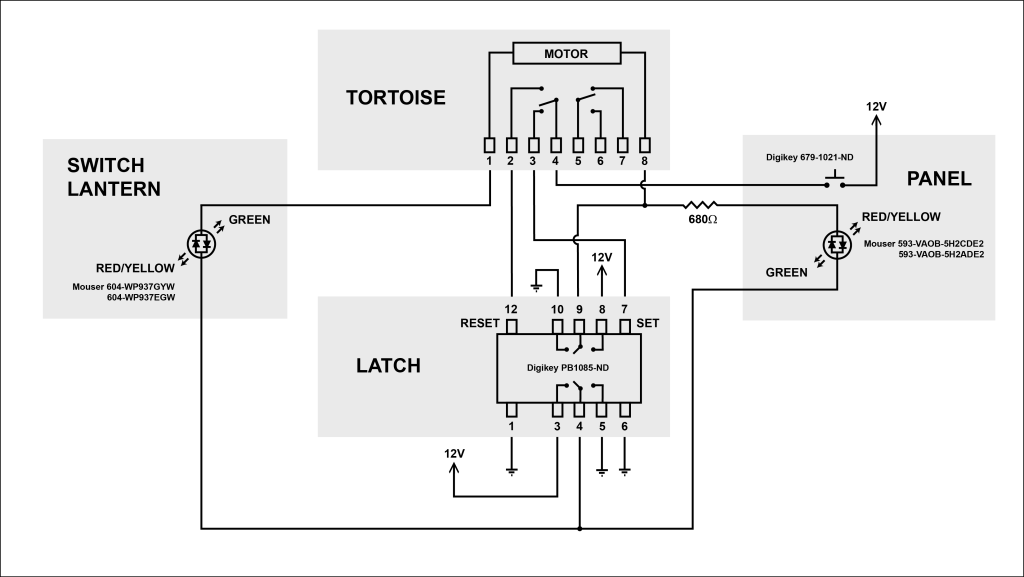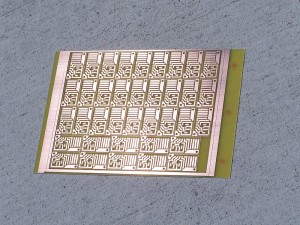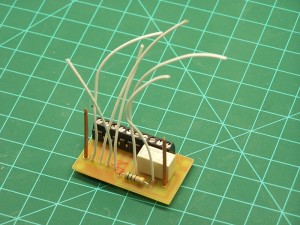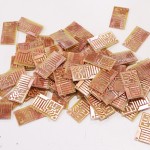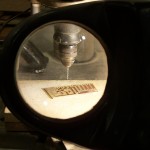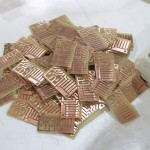This is a follow-up post to the original Tortoise relay project located here: https://lkorailroad.com/tortoise-control/
Remember this video?
I was unhappy with the relay wired point-to-point and glued onto the Tortoise as originally constructed. The exposed relay pins proved to be too fragile and easily bent causing short circuits. Add to this the circuit was wasteful with wire since I had to install very long leads assuring they would reach the fascia control panel. Would have ended up cutting off a lot of wire for the units close to their respective panel and you know how things work… would probably have found some leads too short for far away panels. And then there is the fact the Tortoise would require unsoldering to remove it from the layout if a problem develops. I played around a bit with experimenters IC boards but the hole spacing was too wide for the relay pin arrangement. I could make the relays fit with a little pin bending but it was a crude answer to the problem. A better solution was in order.
I decided to make a printed circuit board (PCB) to hold the relay. This permitted me to add a terminal strip so the Tortoise can connect to the layout with easily attached and, if needed, removed wires in screw terminals. Not directly related to making a PCB but an enhancement made at the same time is the addition of a second LED connection. Unlike the original LED connection which is in series with the Tortoise motor, the newly added LED connection incorporates a current limiting resistor on the PCB and is wired in parallel with the Tortoise motor. This gives me two LEDs that color change with switch position. The original series wired LED will now be in the switch stand while the new parallel LED will be on the fascia panel. There is a 2 volt drop across a LED. If I had placed two LEDs in series with the Tortoise it would have reduced the Tortoise drive voltage to 8 volts which will work but makes the Tortoise movement too slow and weak for my tastes. I really like the Tortoise action at 10 volts (one LED in series). There is another advantage to limiting the fascia panel LED with a resistor. Doing so allows me to tailor the resistance so all the fascia panel LEDs are of equal brightness.
Here is an updated schematic:
Here is the PCB mask file if you wish to make your own: Tortoise_control_PCB_mask
So, I set about making PCBs. In years past I have made PCBs a couple different ways. Initially I would draw the circuit on a copper board with a Sharpie pen, etch in ferric chloride, drill, and assemble. This process worked but was very limited by the fact I was drawing with a Sharpie. Drawing mistakes were a pain to fix and the etchant often undercut the edges of the ink. And truthfully, the boards produced this way looked very amateur. A better but more expensive method used UV photo-sensitive copper boards, a negative mask, and a source of strong UV namely a $40 bulb which I accidentally broke long ago. When done correctly this process produced a nice board but it was difficult to manage the exposure and etching. On more than one occasion my efforts yielded poor results. For the Tortoise PCBs I decided to try something new to me – positive resist board making.
Here is a video that clearly explains the process. With a few exceptions I used it as my guide.
I bought the pre-sensitized board and developer solution from Circuit Specialists. The exceptions for me from the video were:
- I used inkjet transparencies because I own an inkjet printer and not a laser printer;
- I did not use red light for the dark work. Instead I worked in the darkened train room with only the slight glimmer of light coming from under the door to see what I was doing. I also kept the sensitive side of the board pointed away from the under door light just to be safe;
- I placed masking tape guides on the picture frame glass to make it easier to align the mask and board in near total darkness.
WOW am I ever impressed with the results. Check out how nice the board came out. And the process was so easy. I’ll detail the steps in the following post if you are interested in making your own. I am sold on the positive resist method. All of my future boards will be made this way. The results are the best I have ever produced.
In the above image each individual board is only 1″ x 1-3/4″. The entire board is 8″ x 12″. The 8×12 board is good for 37 Tortoise boards. I made two of them for a total of 74 boards.
Next I cut them into individual boards with a jig saw fitted with a fine tooth metal cutting blade. I actually made for myself a poor man’s band saw by turning the jig saw upside down clamped between a pair of 2x10s. The foot of the jig saw became my table and I was able to feed circuit board into the blade as if it were a band saw. Rude, crude, and socially unacceptable but it worked great. No, sorry I did not take a picture and I am not sure I would post it if I had. 🙂 A little edge sanding on the disc sander cleaned up the edges after cutting.
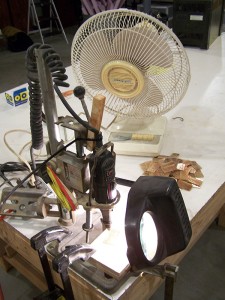 Drilling the boards was easy but oh so monotonous. A total of 2220 holes were drilled to make 74 boards. With the Dremel coerced into a drill press attachment made for a hand drill I set about drilling. Notice the mass of rubber bands on the drill press? My solution to rid the fixture of slop. Can’t use a drill that has more side-to-side slop than the diameter of the bit! Speaking of bits, a 0.030″ bit was used for all of the holes except the terminal strip and the 14 gauge supporting connections. The terminal strip required 0.040″ holes while the large copper necessitated 1/16″ holes. After drilling, the boards were lightly sanded with 320 grit sandpaper to clear drilling burs and then final cleaned with lacquer thinner to remove any hand oils prior to soldering.
Drilling the boards was easy but oh so monotonous. A total of 2220 holes were drilled to make 74 boards. With the Dremel coerced into a drill press attachment made for a hand drill I set about drilling. Notice the mass of rubber bands on the drill press? My solution to rid the fixture of slop. Can’t use a drill that has more side-to-side slop than the diameter of the bit! Speaking of bits, a 0.030″ bit was used for all of the holes except the terminal strip and the 14 gauge supporting connections. The terminal strip required 0.040″ holes while the large copper necessitated 1/16″ holes. After drilling, the boards were lightly sanded with 320 grit sandpaper to clear drilling burs and then final cleaned with lacquer thinner to remove any hand oils prior to soldering.
Here is a finished board with relay, terminal strip, and LED current limiting resistor installed. The two 14 gauge bare copper wires are both conductors and the physical support to mount the PCB to the Tortoise. No gluing to the Tortoise with this design. The board is held tightly against the Tortoise by the 14 gauge wire.
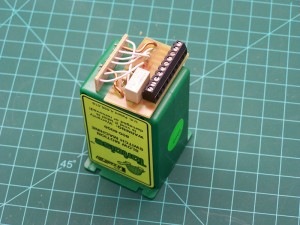 Finally, a finished Tortoise assembly ready for mounting on the layout. The screw terminals provide attachment of the fascia panel switch and LED, switch stand LED, 12 volt Tortoise power, track power, and frog juice. This is a much cleaner, more reliable method than the old point-to-point wiring of the original model.
Finally, a finished Tortoise assembly ready for mounting on the layout. The screw terminals provide attachment of the fascia panel switch and LED, switch stand LED, 12 volt Tortoise power, track power, and frog juice. This is a much cleaner, more reliable method than the old point-to-point wiring of the original model.
Now all I have to do is make 71 more just like this one!
